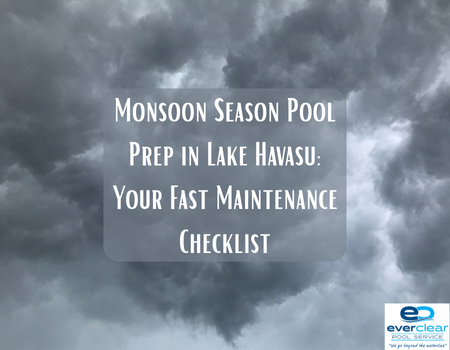Lake Havasu City is known for its scorching summers and sun-soaked pool days, but when monsoon season rolls in—typically between July and September—it brings a new set of challenges for pool owners. Sudden windstorms, heavy rain, blowing dust, and debris can all wreak havoc on your backyard oasis if you’re not prepared.
If you’ve lived in Arizona long enough, you know that monsoon season storms can roll in fast and leave behind a mess. The good news? With a proactive maintenance plan, you can protect your pool, prevent damage, and avoid hours of post-storm cleanup.
Here’s your fast, effective checklist for preparing your Lake Havasu pool for monsoon season—so you can focus less on the mess and more on enjoying your swim time.
1. Secure Pool Accessories and Outdoor Furniture
 Before the storm hits, take a walk around your pool area and secure or store any loose items. High winds can quickly turn patio furniture, umbrellas, floaties, and pool toys into dangerous projectiles—not just damaging your property, but also ending up in the pool.
Before the storm hits, take a walk around your pool area and secure or store any loose items. High winds can quickly turn patio furniture, umbrellas, floaties, and pool toys into dangerous projectiles—not just damaging your property, but also ending up in the pool.
What to do:
- Store lightweight items in a shed or garage
- Anchor down heavier pieces if they must stay outside
- Remove or close umbrellas and retract awnings
- Take pool covers off if they aren’t safety-secured (they can trap debris and tear)
2. Trim Nearby Trees and Plants
One of the most common post-monsoon pool problems in Lake Havasu is plant debris—leaves, twigs, seed pods, and even entire branches ending up in the water. This not only clogs your skimmer and filters but also throws off your pool chemistry fast.
Preventive tips:
- Trim overhanging branches, especially those near the pool
- Remove dead leaves or weak limbs that could easily break off
- Clean up landscaping beds to minimize flying dirt and mulch
3. Balance Your Water Chemistry Before the Storm
Rainwater can dilute and disrupt the balance of your pool water. A sudden downpour often leads to lower chlorine levels and a drop in pH, opening the door for algae growth, cloudiness, and staining.
Before monsoon activity begins, test your water and make sure the chemical levels are properly balanced:
- Chlorine: 1–3 ppm
- pH:4–7.6
- Alkalinity: 80–120 ppm
- Calcium Hardness: 200–400 ppm
- Cyanuric Acid (Stabilizer): 30–50 ppm
Adding a little extra chlorine or algaecide before a storm can help fight off contaminants introduced by rain, dust, or debris.
4. Run the Pool Pump Longer Before and After Storms
Storms introduce a lot of organic matter—dust, insects, leaves, and other debris—that can throw your water off-balance. Increasing your pool pump runtime helps keep water circulating and filtering properly to remove impurities faster.
Best practice:
- Run your pump 10–12 hours a day during stormy periods
- Backwash or clean filters regularly to prevent clogs
If you’re expecting a big storm, keep the pump running during the storm if it’s safe to do so. Just make sure electrical components are properly protected.
5. Use a Pool Enzyme Treatment
To fight off the inevitable organic load that comes from a dusty storm, many Lake Havasu pool owners use enzyme-based pool products. These break down oils, pollen, and organic waste, preventing scum lines, cloudy water, and chlorine loss.
Add enzymes before and after the storm for best results—especially if you have a lot of plants nearby or heavy rain is in the forecast.
6. Install or Maintain a Pool Overflow Drain
Monsoon rains can dump inches of water in just a few hours. If your pool doesn’t have a functioning overflow drain, excess water can flood the deck or yard, potentially damaging landscaping or nearby structures.
What to check:
- Make sure your pool’s overflow outlet is clear of debris
- If you don’t have one, consider installing a backwash or submersible pump as a temporary solution
- After a storm, test water levels and drain a few inches if needed
7. Post-Storm Cleanup: Act Fast
After the skies clear, quick action makes all the difference in restoring pool health. Start by:
- Skimming debris from the surface
- Vacuuming the pool floor
- Cleaning out skimmer baskets and filters
- Re-testing and balancing water chemistry
- Shocking the pool if water is cloudy or smells like chlorine
Avoid swimming until the water is balanced and debris is removed—it’s not just about appearance; it’s about safety and hygiene.
Monsoon season in Lake Havasu doesn’t have to spell disaster for your pool. With a simple maintenance checklist and a little preparation, you can protect your investment and enjoy clear, safe swimming all summer long.
Stay ahead of the storms, partner with a local pool care professional if needed, and keep your pool monsoon-ready—because in Arizona, being prepared is just smart pool ownership.
